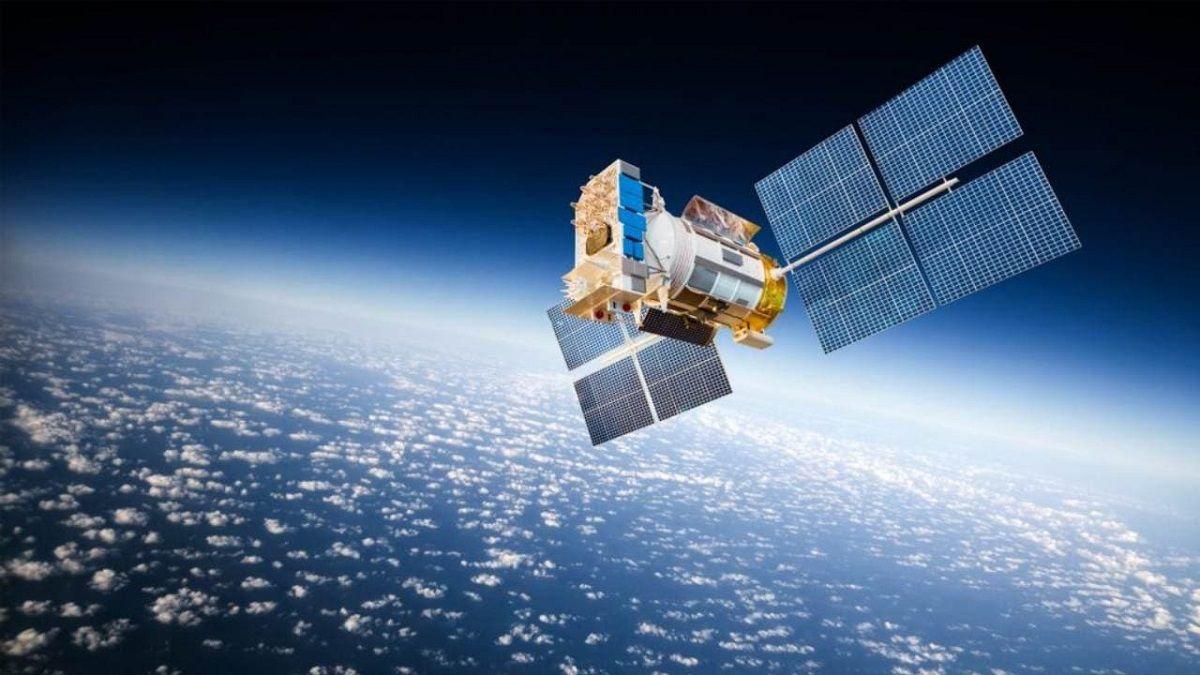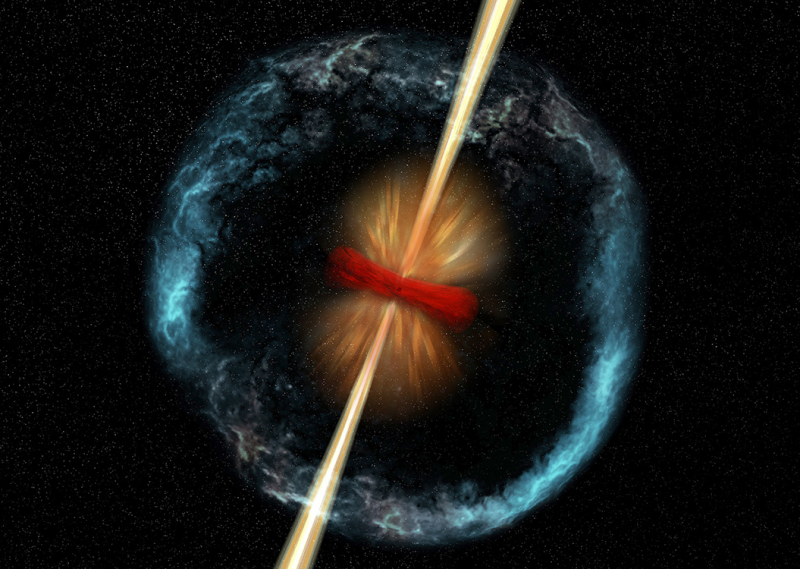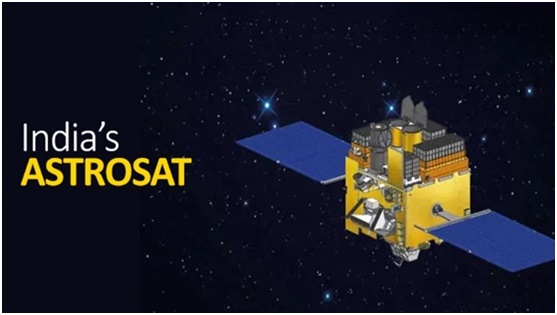AstroSat

- 01 Oct 2025
In News:
India’s first dedicated Space Astronomy Observatory — AstroSat — has successfully completed a decade of operations since its launch on September 28, 2015. Designed for a mission life of five years, AstroSatcontinues to deliver valuable scientific data, marking a major milestone in India’s advancement in space-based astrophysics research.
About AstroSat
- Launched by: Indian Space Research Organisation (ISRO)
- Launch Vehicle: PSLV-C30 (XL)
- Launch Site: Satish Dhawan Space Centre (SDSC), Sriharikota
- Launch Date: September 28, 2015
- Mission Life: Originally 5 years, extended due to sustained functionality and scientific output
- Managed by:Mission Operations Complex (MOX) of ISTRAC, Bengaluru
AstroSat represents India’s first multi-wavelength space observatory, capable of observing celestial bodies in Visible, Ultraviolet (UV), and low and high-energy X-ray bands of the electromagnetic spectrum simultaneously — a capability possessed by only a handful of space observatories globally.
Scientific Objectives
AstroSat was conceived to advance India’s capability in space-based astronomy and to deepen understanding of high-energy astrophysical phenomena. Its key scientific goals include:
- Investigating high-energy processes in binary star systems containing neutron stars and black holes.
- Estimating magnetic field strengths of neutron stars.
- Studying star formation regions and energetic star systems beyond the Milky Way.
- Detecting and monitoring transient X-ray sources (brief, bright cosmic events).
- Conducting a limited deep-field survey of the universe in the ultraviolet region.
Key Instruments (Payloads)
AstroSat carries five scientific payloads, each contributing to multi-spectral observations:
- Ultra Violet Imaging Telescope (UVIT):Observes celestial objects in near and far ultraviolet as well as visible wavelengths, helping in the study of star formation and evolution.
- Large Area X-ray Proportional Counter (LAXPC):Detects time variability and spectral properties of X-ray sources in the 3–80 keV range.
- Cadmium–Zinc–Telluride Imager (CZTI):Observes hard X-rays (above 20 keV) and helps study gamma-ray bursts and black hole emissions.
- Soft X-ray Telescope (SXT):Provides soft X-ray imaging and spectroscopy to study compact objects like neutron stars and white dwarfs.
- Scanning Sky Monitor (SSM):Continuously scans the sky to detect new transient X-ray sources and track their variability.
AstroSat detects millisecond X-ray bursts from high magnetic field neutron stars (DD News)

- 26 Dec 2023
Why is it in the News?
India’s first multi-wavelength space-based observatory, AstroSat, has detected intense sub-second X-ray bursts emanating from a neutron star with an ultrahigh magnetic field, known as a magnetar.
What is X-ray Bursts?
- X-ray bursts manifest in low-mass X-ray binary systems featuring a neutron star and a low-mass main sequence star orbiting each other.
- The occurrence of these bursts is intricately linked to the gravitational dynamics of the neutron star and its companion.
- In this system, the proximity and intense gravitational forces of the neutron star cause the companion star to exceed its Roche-lobe, leading to the formation of an accretion disk around the neutron star.
- This disk becomes a repository for hydrogen drawn from the overflowing companion star.
- As hydrogen accumulates on the neutron star's surface, the extreme temperatures and pressures prevailing there catalyze its transformation into helium.
- This ongoing process results in the formation of a thin surface layer of helium.
- When this helium layer reaches a critical mass, a sudden explosive ignition occurs, elevating the entire neutron star's surface temperature to several tens of millions of degrees and releasing a burst of X-rays.
- Following the outburst, the binary system returns temporarily to a quiescent state, allowing the neutron star to reaccumulate the helium surface layer gradually.
- This cyclic process leads to the recurrence of X-ray bursts, typically unfolding at regular intervals separated by several hours or days.
About Indias’ AstroSat:
- AstroSat stands as India’s first dedicated multi-wavelength space observatory, pioneering a mission focused on the simultaneous study of celestial sources across X-ray, optical, and UV spectral bands.
- Launched with a lift-off mass of 1515 kg, AstroSat took flight aboard the Indian launch vehicle PSLV from the Satish Dhawan Space Centre in Sriharikota on September 28, 2015.
- It entered a 650 km orbit, inclined at an angle of 6 degrees to the equator.
- The Mission Operations Complex (MOX) at ISRO Telemetry, Tracking and Command Network (ISTRAC) in Bengaluru oversees the satellite throughout its mission life.
- With a minimum useful life of around 5 years, AstroSat is dedicated to achieving the following scientific objectives:
- Understanding high-energy processes in binary star systems housing neutron stars and black holes.
- Estimating magnetic fields associated with neutron stars.
- Investigating star birth regions and high-energy processes in star systems beyond our galaxy.
- Detecting new, briefly bright X-ray sources in the celestial sphere.
- Conducting a limited deep-field survey of the Universe in the Ultraviolet region.
ISRO's AstroSat (PTI)

- 28 Nov 2023
Why is it in the News?
India's AstroSat space telescope has achieved a significant milestone by detecting more than 600 Gamma-Ray Burst (GRB), each marking the death of a massive star or merging of neutron stars.
About ISRO’s AstroSat:
- AstroSat is the first dedicated Indian astronomy mission aimed at studying celestial sources in X-ray, optical, and UV spectral bands simultaneously.
- One of the unique features of the AstroSat mission is that it enables the simultaneous multi-wavelength observations of various astronomical objects with a single satellite.
- AstroSat, with a lift-off mass of 1515 kg, was launched by the Indian launch vehicle PSLV from Satish Dhawan Space Centre, Sriharikota, on September 28, 2015, into a 650 km orbit inclined at an angle of 6 degrees to the equator.
- The minimum useful life of the AstroSat mission is expected to be 5 years.
- It carried a total of five scientific payloads, enabling imaging and studying the temporal and spectral properties of galactic and extra-galactic cosmic sources in a wide range of wavelengths on a common platform.
- The scientific objectives of AstroSat’s mission are:
- To understand high energy processes in binary star systems containing neutron stars and black holes.
- Estimate magnetic fields of neutron stars.
- Study star birth regions and high energy processes in star systems lying beyond our galaxy.
- Detect new briefly bright X-ray sources in the sky.
- Perform a limited deep-field survey of the Universe in the Ultraviolet region.
- At present, all the payloads are operational and are observing the cosmic sources.
